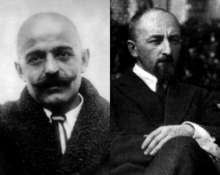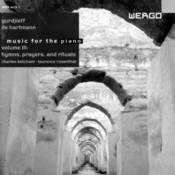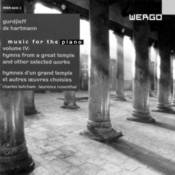
Gurdjieff International Review
Gurdjieff / de Hartmann Music for the Piano
Wergo / Schott Recordings
by Eugene E. Foster
In 1929, when Thomas de Hartmann and his wife took leave of G. I. Gurdjieff at Gurdjieff’s Institute near Paris, they left behind a steamer trunk filled with manuscript music, much of which is recorded here for the first time. The music was composed by Gurdjieff and de Hartmann in a collaboration witnessed daily by the community of Gurdjieff’s pupils and documented both in de Hartmann’s book Our Life with Mr Gurdjieff and in the well-preserved sequence of manuscript drafts. One thing is clear: an exceptional musical event occurred at the Institute for the Harmonious Development of Man in the years 1925–27, and its enduring result is this body of music.
From the time of its composition until Gurdjieff’s death in 1949, this music remained unpublished and was performed, almost exclusively within the circle of Gurdjieff’s pupils, by various pianists but principally by de Hartmann himself. Then, in the early 1950s, a selection of pieces was privately published and a series of recordings was made—with amateur equipment—of de Hartmann playing a selection of works from this repertory. Despite their technical limitations, these impromptu recordings have the authority of a composer’s performance.
At the time of Gurdjieff’s death, he entrusted the continuation of his work to his closest pupil, Jeanne de Salzmann, herself an accomplished pianist, who had witnessed at Gurdjieff’s Institute the birth of this repertory. It was a long-standing wish of Mme de Salzmann to see this music published in its entirety, and in this connection she invited Lord Pentland, the President of the Gurdjieff Foundation of New York, to help achieve this aim. In response to her request, Lord Pentland, in 1983, proposed to three musicians, well acquainted with this repertory, Linda Daniel-Spitz, Charles Ketcham, and Laurence Rosenthal, that they assume the task of editing a definitive edition. He brought them together with Thomas C. Daly, the executor of the de Hartmann estate, who had already prepared a meticulous archive of the manuscripts. Under the guidance of Mme de Salzmann, a consortium was beginning to take shape. When Schott Musik International agreed to publish the scores of what evolved into the present four-volume edition, there evolved a plan for a complete parallel recording to accompany the publication and to document a tradition of performance that de Hartmann himself had established. In fact, de Hartmann and Mme de Salzmann had worked with certain skilled musicians in New York, as well as in Paris, London, and San Francisco, in search of the most faithful transmission of the essence of this music. In the last decade of her life, Mme de Salzmann worked with the three musicians who edited the Schott edition and who perform in this recording.
One must not forget that this is music from a school—not in the familiar sense of a conservatory but in a less familiar sense. Gurdjieff’s Institute for the Harmonious Development of Man, where this music was written and first performed, was a school in the ancient sense, comparable perhaps to the circle around Pythagoras: a school whose aim was self-knowledge, and the development of consciousness. The Institute’s activities, while reflecting Gurdjieff’s broader aims and philosophy, gave to certain forms of music and art a central place in the program of study.
Gurdjieff and de Hartmann jointly brought to the music the most diverse imaginable experience and training. From his childhood in Russian Armenia, a region of ethnic and therefore musical diversity, to his travels across Central Asia as far as Tibet, and in North Africa as far as Abyssinia, Gurdjieff encountered a rich variety of music and dance. He gathered its essential features preserved by countless generations, from simple peasant melodies to sacred chants, and gave them new life in the West. For his part, de Hartmann brought a highly developed musical training and the creative energy that would no doubt have been invested in continuing the Russian tradition in music, had he remained in his homeland—but a promising composer who had been favored by the Czar had no place in Lenin’s Russia.
The contributions of Gurdjieff and de Hartmann, overlapping and distinctive, are ultimately inseparable from one another. It is clear that Gurdjieff provided melodies and rhythms, and that de Hartmann provided harmonizations and structural details—but which of the collaborators is responsible, for example, for the haunting dissonances that seem to have a dual debt to Asian microtonal intervals and to early 20th century innovations? Which is responsible for the great hymns (in the third and fourth albums), which are evocative of the Russian Orthodox liturgy yet depart from that model in altogether distinctive ways? Which is responsible for the peasant vigor or poignant innocence of some of the simple, heartfelt melodies, which seem to speak to our subconscious? De Hartmann was well aware of the folklore studies of the Russian school, of the Armenian Komitas Vardapet, of Bartók, Grieg, and others. And Gurdjieff, without formal musical training, revealed, when he played on the harmonium for his pupils, an intuitive sense of melodic form and a deep understanding of sacred music.
The inextricable collaboration of Gurdjieff and de Hartmann is echoed by the collaborative gesture of the three musicians, who have chosen not to document which of them is at the piano for any given piece.

Volume I
Asian Songs and Rhythms
WER 6284-2
The music of Asian Songs and Rhythms can be considered as an homage to the peoples of the Near East and Central Asia, and to Gurdjieff’s own Armenian and Greek ancestry. The musical folklore of these ethnic groups, among which he lived and traveled as a young man, was a primary influence on his own tonal language.
It must be said at once that many of the titles cannot be taken literally. In some cases the music may indeed be an accurate recollection or echo of certain regional melodies Gurdjieff heard on his journeys, which he either quoted directly, or re-created in the idiom of the locale. In other instances, the titles would seem to reflect a personal impression of a place or a people, translated into Gurdjieff’s own musical language, or even an evocation of an ancient culture. A number of pieces were left untitled, but clearly belong to the genre of this album.
In any case, there is a remarkable variety of styles within the generally folkloristic idiom. For example, there is a series of Greek pieces found throughout the volume which are largely diatonic, often in straightforward major keys, with a candid, cheerful, almost childlike simplicity. By contrast, the Kurdish pieces tend to be more subjective, soulful, often in minor modes, and even when lively in tempo (No. 19) or with curious dissonances of the ninth (No. 4), still radiate an elusive, underlying sadness. The Armenian pieces have a natural musical directness and human warmth, while the Persian Song (No. 6), surely one of the finest of the set, consists of a long, searching melodic line, underpinned by a slow, swaying rhythm and subtly shifting chromatic harmonies which convey an atmosphere of inwardness and mystery which goes far beyond the limits of most conventional folk-music.

Volume II
Music of the Sayyids and the Dervishes
WER 6292-2
The music of the Sayyids and Dervishes occupies a special place in the entire body of works by Gurdjieff and de Hartmann. While these compositions characteristically reflect the musical idiom of the Middle East, one might say that—in contrast to the folkloristic pieces or the sacred hymns and rituals—they reveal a more personal or subjective quality of expression.
The music of the Dervishes still exists today and has been preserved, for the most part, in traditional form. Dervishes belong to different Islamic orders as varied as those in Christianity, in which devotional and spiritual exercises are linked to musical forms defined by tradition. Gurdjieff was, during his travels, in contact with many of these brotherhoods, especially in Central Asia and the Near East, and was undoubtedly influenced by their music. The Mevlevi, for example, best known in the West as the Whirling Dervishes, give an important place to dance, which, along with the music, opens the way to an ecstatic state.
The Dervish pieces are thus often characterized by powerful dance rhythms, full of spiritual fervor (Nos. 14, 27, 36, and 37, for example). But in spite of the forceful expression, the ardor in this music is intensely inward. Dances of this kind are not meant to induce a trance-like frenzy, but, quite to the contrary, provide a specific rhythmic support for the control of the breath and an inner spiritual awakening.
The music of the Sayyids, on the other hand, presents more of a mystery. The Sayyids, whether by blood relation or spiritual lineage, are considered to be direct descendants of the prophet Mohammed, and are held in great esteem in the Muslim World. But so far as is known they have left no music that can be specifically attributed to them.

Volume III
Hymns, Prayers and Rituals
WER 6625-2
In considering the complete musical works of Gurdjieff / de Hartmann, we find in Hymns, Prayers, and Rituals undoubtedly the most profound reflection of Gurdjieff the Master. Although quite varied in form and somewhat in style, these pieces all share the unmistakable mark of the depth of his inner feeling and sensitivity. It is surely this quality which gives Volume III its unique tone.
The ethnic and traditional pieces in Volumes I and II clearly emerge from Gurdjieff's early life-experiences and travels in Asia and North Africa and are suffused with natural human warmth and often with refined personal emotion. The music of Volume III, however, leaves behind all folklorism or any purely subjective expression, to reveal another world.
The exact nature of this collection of pieces is difficult to define. They all evoke a sense of the sacred, but in different ways. Some were given titles, while other are identified only by number. In certain pieces the distinction between a hymn, a prayer, and a ritual is not immediately evident.
The hymns, for example, do not at all correspond to the conventional notion of music sung by church congregations or choirs. They might instead be viewed as expressions of inner states in which man confronts his inmost self—sometimes through a dramatic struggle—to become aware of the different forces which influence both his life and his inner being.

Volume IV
Hymns from a Great Temple and other Selected Works
WER 6643-2
A major part of the musical oeuvre of Gurdjieff and de Hartmann—and from a certain point of view perhaps the most important part—is comprised of the sacred hymns. It is in these works that one finds, remarkably, the most inward and, at the same time, the most nearly objective expression in all of this body of music.
Among these sacred hymns there is a group of ten, which were singled out under the title Hymns from a Great Temple. While the exact significance of this designation remains mysterious, it is clear that in these hymns one discovers an often enigmatic music, which seems to take us directly to the heart of Eastern Christianity. As in all of the pieces called Hymns, the forms of the Great Temple Hymns are not in any way related to the conventional notion of a church hymn. They may be ceremonial or ritualistic in character, but that is merely their exterior guise. Within that form, as in so many of these pieces, even dances or songs, lies a quality of deep interior questioning, a yearning for Truth.
In certain of these ten hymns, the quality of the sacred may emerge only after repeated hearings, when the music had been allowed to penetrate beyond our usual associative patterns. And still they may appear cryptic and elusive. Their real meaning seems to remain hidden. And perhaps it is just those hymns that refuse to yield up their secret that finally leave the deepest and most enduring impression. Like silent sphinxes, their essence remains to be received.
| Vol I: Asian Songs and Rhythms | 2-CD Set, 49 pieces | $45 |
| Printed Music | $28 | |
| Vol II: Music of the Sayyids and the Dervishes | 2-CD Set, 42 pieces | $45 |
| Printed Music | $28 | |
| Vol III: Hymns, Prayers and Rituals | 3-CD Set, 51 pieces | $45 |
| Printed Music | $28 | |
| Vol IV: Hymns from a Great Temple and other Works | 2-CD Set, 24 pieces | $45 |
| Printed Music | $28 |
Send check or money order payable to: The Gurdjieff Foundation of California, Attn: Kim Sutton, 3119 20th Street, San Francisco, CA 94110-2714. Plus $5.00 shipping. Please allow 3–4 weeks for delivery. Add 8.25% sales tax for delivery in California.
|
Copyright © 1997 Wergo / Schott Music & Media GmbH This webpage © 1999 Gurdjieff Electronic Publishing Featured: Summer 1999 Issue, Vol. II (4) Revision: January 1, 2006 |